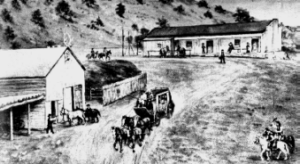Virginia Dale, Colorado

Virginia Dale Stage Station in 1860's


Virginia Dale Stage Station in 1860's

Established in 1862, Virginia Dale was the first division point northwest of Denver on the Overland Stage Line when Ben Holladay moved the line from the North Platte route of the Oregon Trail, to the South Platte.
Virginia Dale is located in the northern part of Larimer County, about 45 miles northwest of Fort Collins, only about 4 miles south of the Wyoming border on US Highway 287. Virginia Dale remained a division point until the Union Pacific Railroad was completed to Cheyenne, in 1867, then abandoned as a stop on the Overland Trail Stage Line.
Joseph A. Slade, better known as "Jack", the first division agent for the stage line, built the house, stage stables and other buildings. The stage station, its walls scarred by bullet holes, is still standing. Slade was certainly notorious, was called a "desperado", and with good cause. When he wasn't drunk, he was shooting up the countryside, riding wild mustangs, and was probably responsible for the stage hold-up a mile from the station which claimed about $60,000, and was never found.
From 1864 to 1866 Virginia Dale was a noted camping place for emigrant trains. By order of the US government, the route from Julesburg, Colorado to Denver, and then north to Virginia Dale, and on to Fort Bridger, Wyoming, was the only route that emigrants were permitted to travel due to the hostility of the Northern Plains Indians. Mark Twain has described Virginia Dale in his novel, Roughing It.
In the spring of 1872, after the station was abandoned as a stage stop, other settlers began to come and locate along the streams and valleys and establish homes and ranches. The first school was erected in 1874, and is still standing.
The first settlers of Virginia Dale were attracted there by its superior advantages as cattle grazing country, and opportunities for dairying. The parks and hillsides afford fine grazing and the valleys along the streams have been converted into splendid meadows, gardens, and orchards. It is a well watered region, with streams furnishing an abundance of water for stock and irrigation.
A church was erected at Virginia Dale in 1880 at Deadman Creek. The finding of a body of a man who had evidently been killed near the stage station by Indians, gave rise to the name, "Deadman," and the creek has been known by that name since.
Virginia Dale today is just a spot on the map; the Post Office is no longer open, the cafe went by the way-side as well. Mail can be sent to "Virginia Dale," but it is re-directed to the Livermore Post Office, about 14 miles to the south.
Virginia Dale remains predominately a ranching area, but with the influx of new people in the Fort Collins and out-lying areas, and the breaking up of a number of the old homesteads and ranches, a revitalization of the area is occuring. A renewed interest in the Stage Station has emerged, and efforts were being made to preserve and restore the old Overland Trail Stage Station by some of the newcomers to the area.
Virignia Dale is located right off US Highway 287, between Fort Collins, Colorado and Laramie, Wyoming, about 4 miles south of the Wyoming border. It is situated at the very end of County Road 43F, about 1 mile east of US 287. A monument erected by the DAR for the Stage Station marks the beginning of CR 43F. Follow the county road through a narrow gorge beneath Lover's Leap, past a ranch, and it will take you right to the door. The station itself is on private property, but the access to the site is on a county road. Lodging can be obtained in Fort Collins, Laramie, and Red Feather Lakes. Livermore, about 14 miles south of Virginia Dale, has an historic restaurant, The Forks, built in 1874.
Please visit other pages on the history of the stage station, some of the personalities connected with it during its prime, and read about previous plans to restore and preserve the old Overland Trail Stage Station.
Send comments, suggestions or inquiries:
[Overland Trail |
Links |
Virginia Dale]
Created and maintained by Elizabeth Larson
Virginia Dale Colorado was one of the most noted localities in the Western United States in the late 1800's. It was known far and wide, its name and fame being spread from ocean to ocean by the Overland Trail Stage travelers, described by magazine writers and newspaper correspondents, and discussed in public places all over the country, often in terms of praise and again with awe and superstition.

 Virginia Dale
Virginia Dale
Copyright © 1996-2000 All Rights Reserved